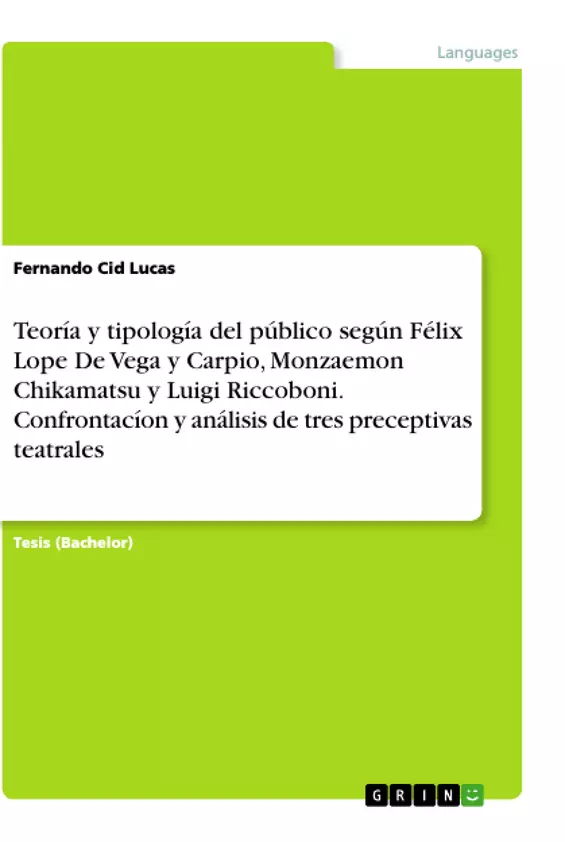This present end-of-degree project analyses, from a theoretical point of view, offers a vast range of data, such as statistical-like texts and great testimonies, the role the audience holds to change the playwrights’ style, the cinema programmes and even the society’s perception of the show and the spectacle over time.
After the first part, which offers the definition of some key terminology for this study, such as ‘drama’ or ‘audience’, or the innovative concept of ‘heterotopia’ opposed to the idea of the neologism coined by the anthropologist, Marc Augé, ‘non-place’, we will center our attention, during the following chapters, on briefly reviewing the perception of the audience’s effect towards the dramatic spectacle according to the theatrical tenets of some of the most canonical authors from the East and the West.
However, the core of our study will be carried out when we analyse and relate the theatrical preceptive writings penned by Félix Lope de Vega y Carpio, Monzaemon Chikamatsu and Luigi Riccoboni. Thus, some concluding remarks of a synoptic nature will be offered.
Inhaltsverzeichnis
- CAPÍTULO I: 1. El público: ese gran desconocido.
- 1.1.Introducción. Algunas definiciones cardinales
- 1.2. ¿Qué nos enseña la crítica literaria sobre el público? Algunas consideraciones generales más el análisis de varios casos paradigmáticos
- 2. El teatro: ese lugar “incómodo\" para la crítica literaria
- 3. El teatro como eterotopía
- 4. La ecuación del teatro (que sin público no funciona)
- CAPÍTULO II: 1. La opinión de los clásicos sobre el público. Comentarios a varios pasajes paradigmáticos.
- 1.1. Introducción
- 1.2. Aristóteles
- 1.3. Horacio
- 1.4. El Pseudo-Longino
- 1.5. Godofredo de Vinsauf
- 1.6. El Natyasastra
- 1.6. Zeami Motokiyo
- CAPÍTULO III: 1. El público según Lope de Vega.
- 1.1. Introducción. Lope de Vega autor teatral: el dramaturgo, el (in)genio
- 1.2. El texto de El arte nuevo de hacer comedias en este tiempo como caso paradigmático de preceptiva teatral del barroco español
- 1.3. El público en El arte nuevo de hacer comedias en este tiempo, de Lope de Vega
- 1.4. Coda: El gusto del “vulgo”según otros autores distintos a Lope de Vega
- CAPÍTULO IV: 1. Educar el gusto del público desde el escenario: Monzaemon Chikamatsu y sus ideas sobre el Bunraku.
- 1.1. Introducción. Apenas unas líneas sobre las diferencias entre el Nō y el Bunraku y el Kabuki
- 1.2. Monzaemon Chikamatsu, el dramaturgo que sabía de moral.
- 1.3. El texto de Naniwa Miyage como ideario dramático de Monzaemon Chikamatsu
- CAPÍTULO V: El hombre que distinguía los aplausos: Luigi Riccoboni y la escena teatral europea de su época.
- 1.1. Unas pocas notas biográficas sobre Luigi Riccoboni
- 1.2. El problema del teatro en la Italia de Luigi Riccoboni
- 1.3. El público según los escritos de Luigi Riccoboni
- 1.4. Coda: Un cierto olor a Molière
Zielsetzung und Themenschwerpunkte
Die vorliegende Arbeit untersucht die Rolle des Publikums in der Theatergeschichte und analysiert die Ansichten bedeutender Theatertheoretiker wie Lope de Vega, Monzaemon Chikamatsu und Luigi Riccoboni. Der Fokus liegt auf der Frage, wie diese Autoren das Publikum in ihren theoretischen Arbeiten konzeptionalisieren und welche Bedeutung sie dem Einfluss des Publikums auf das Theater zuschreiben.
- Die Entwicklung des Publikumsbegriffs in der Theatergeschichte
- Die Rolle des Publikums in der theatralischen Kommunikation
- Die Beziehung zwischen Theater und Gesellschaft
- Der Einfluss von Theater auf die Moral und die Bildung des Publikums
- Die Rolle des Geschmacks des Publikums in der theatralischen Produktion
Zusammenfassung der Kapitel
Kapitel I führt in das Thema der Arbeit ein und definiert den Begriff des Publikums, indem es verschiedene Definitionen aus der Theaterwissenschaft und der Literaturwissenschaft zusammenfasst.
Kapitel II beleuchtet die Ansichten über das Publikum bei klassischen Theaterautoren wie Aristoteles, Horaz, Pseudo-Longinus, Godofredo de Vinsauf, Zeami Motokiyo und dem Natyasastra.
Kapitel III konzentriert sich auf die Theorien von Lope de Vega über das Publikum und analysiert dessen Werk „El arte nuevo de hacer comedias en este tiempo“.
Kapitel IV behandelt die Ansichten des japanischen Autors Monzaemon Chikamatsu über das Publikum und untersucht dessen Werk „Naniwa Miyage“.
Kapitel V widmet sich den Schriften des italienischen Theaterkritikers Luigi Riccoboni und untersucht seine Auffassungen über das Publikum in der europäischen Theaterlandschaft seiner Zeit.
Schlüsselwörter
Theatergeschichte, Publikum, Theatertheorie, Lope de Vega, Monzaemon Chikamatsu, Luigi Riccoboni, Barocktheater, Bunraku, italienische Theaterkultur, theatralische Kommunikation, Moral, Geschmack, Bildung.
- Quote paper
- Fernando Cid Lucas (Author), 2021, Teoría y tipología del público según Félix Lope De Vega y Carpio, Monzaemon Chikamatsu y Luigi Riccoboni. Confrontacíon y análisis de tres preceptivas teatrales, Munich, GRIN Verlag, https://www.grin.com/document/1164330



